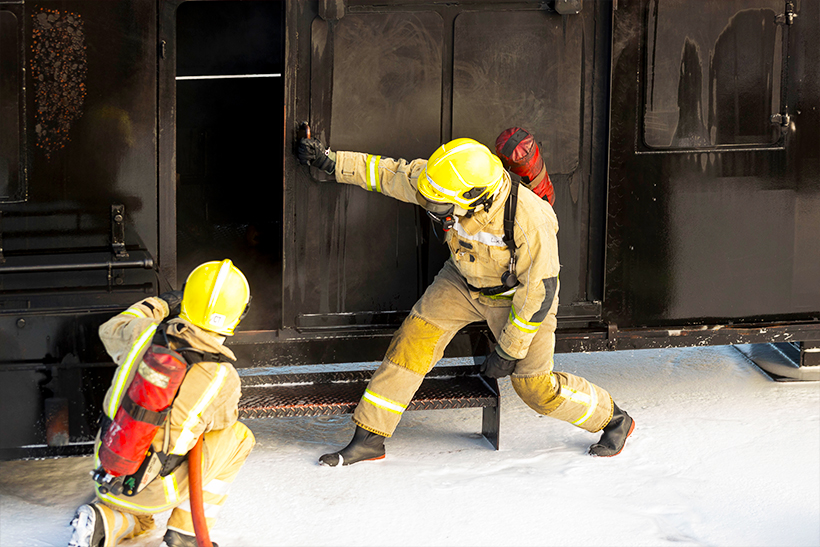Course
Helideck Emergency Response Team Leader
Aim
The aim and objectives of the Helideck Emergency Response Team Leader Training programme are:
HERTLs to understand the importance of pre-planning for and the main elements of the response requirement for a range of helideck and helicopter emergencies.
HERTLs to understand the importance of emergency response practice via onshore training and offshore drills.
HERTLs to understand the requirement for different types of emergency response systems and controls.
Understand how the limited emergency response capability on an NUI can affect NUI helideck emergency response.
The roles and responsibilities of both the HERTL and the Helideck Emergency Response Team during a helicopter-related emergency.
Understanding the human factors issues during emergencies and how to manage them.
Leading the Helideck Emergency Response Team during a range of typical helideck simulated emergency scenarios – some of which involve live fires, in a safe and controlled manner.
Learning Outcomes
Define the role and key responsibilities of a HERTL.
State the main elements of helideck emergency response plan.
Identify typical organisations involved in a helicopter emergency response.
Identify types of potential offshore helideck emergencies.
State the general firefighting safety goals and objectives.
Explain the purpose of typical helideck emergency systems and controls.
Explain the main differences between helideck emergency response on a main fixed or floating installation and a normally unattended installation (NUI).
To successfully complete this training programme, delegates must be able to perform:
Emergency access and egress to and from helidecks including clear, concise and effective communications with all relevant ER personnel.
Directing the helideck team in a clear and confident manner during emergencies including the correct selection of appropriate fire-fighting equipment for the incident.
Directing entry to the incident area in a controlled manner – continually assessing how the changes in the emergency could impact on the safety of the HERT members, maintaining a means of escape from the incident area.
Effective delegation of emergency response tasks to team members
Controlling helicopter incident firefighting operations, to include responding to a helicopter engine fire using a CO2 media extended applicator.
Ensure correct donning, use and monitoring of breathing apparatus (BA) of HERT members (all delegates to practice donning and using BA).
Effective Search and rescue (SAR) principles and techniques – on or close to the helideck, locating, extracting and handling missing personnel and casualties following a helicopter incident on the helideck.
Appropriate response to non-firefighting operations during helicopter incident.
Ensuring effective use of firefighting fixed, portable and mobile systems, including fixed fire monitors, dry chemical and CO2 fire extinguishment and control media
Responding to an NUI helideck fire (with limited firefighting equipment).
Utilising back-up ER Team via the Team Leader (this only requires briefing the back-up team leader).
Missing personnel and casualty management
Hose-running techniques and associated hazards
Conducting dynamic risk assessment during the emergency situation and obtaining feedback against the plan
Continually monitoring human factors
Assessment
Delegates will be assessed against the learning outcomes using direct observation and oral and/or written questions as appropriate.
Delegates Pre-requisites
The prerequisites for this training programme are:
A valid OPITO Helideck Operations Initial Training certificate AND
A valid OPITO Helideck Emergency Response Team Member Certificate or a valid Helideck Emergency Response Team Member Further Certificate AND
A valid Radio Operators Certificate of Competence (ROCC) – UKCS Operations only.
Course
Helideck Emergency Response Team Leader Further
Aim
The aim and objectives of the HERTL Further Training Programme is to refresh elements of HERTL training that cannot be completed in the workplace and updating HERTLs on key changes to helicopter operations, systems, relevant legislation and regulation over the previous 2 years (approx.)
Learning Outcomes
To successfully complete this programme, delegates must be able to demonstrate:
Emergency access and egress to and from helidecks including clear, concise and effective communications with all relevant ER personnel.
Directing the helideck team in a clear and confident manner during emergencies including the correct selection of appropriate fire-fighting equipment for the incident.
Directing entry to the incident area in a controlled manner – continually assessing how the changes in the emergency could impact on the safety of the HERT members, maintaining a means of escape from the incident area.
Effective delegation of emergency response tasks to team members
Controlling helicopter incident firefighting operations, to include responding to a helicopter engine fire using a CO2 media extended applicator.
Ensure correct donning, use and monitoring of breathing apparatus (BA) of HERT members (all delegates to practice donning and using BA).
Effective Search and rescue (SAR) principles and techniques – on or close to the helideck, locating, extracting and handling missing personnel and casualties following a helicopter incident on the helideck.
Appropriate response to non-firefighting operations during helicopter incident.
Ensuring effective use of firefighting fixed, portable and mobile systems, including fixed fire monitors, dry chemical and CO2 fire extinguishment and control media
Responding to an NUI helideck fire (with limited firefighting equipment).
Utilising back-up ER Team via the Team Leader (this only requires briefing the back-up team leader).
Missing persons and casualty management, to include:
Prioritising
Accounting for missing personnel
Casualty handling techniques
Hose-running techniques and associated hazards
Conducting dynamic risk assessment during the emergency situation and obtaining feedback against the plan
Continually monitoring human factors during emergency response including;
Stress affecting decision making in self and team
Physical limitations of self and team
Assessment
Delegates will be assessed against the learning outcomes using direct observation and oral and/or written questions as appropriate.
Delegates Pre-requisites
(a) A valid OPITO Helideck Emergency Response Team Leader Training Certificate
or
(b) A valid OPITO Helideck Emergency Response Team Leader Further Training Certificate
Or
(c) A valid OPITO Helideck Operations Initial Training certificate and a valid Helideck Emergency Response Team Member (HERTM) certificate and a valid Offshore Emergency Response Team leader (OERTL) Certificate.
Validity
2 years
